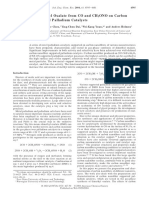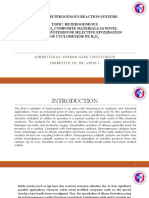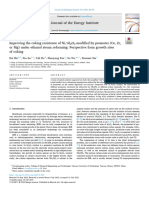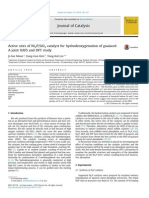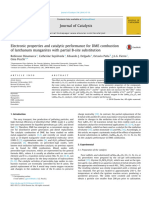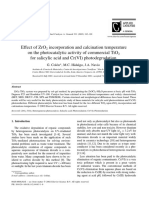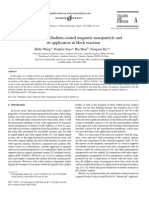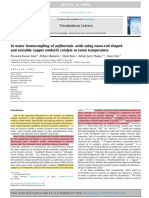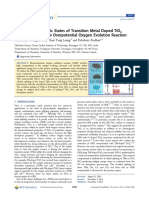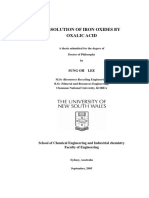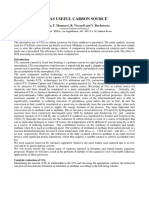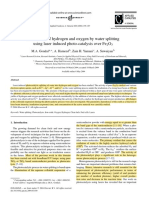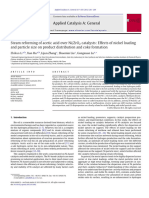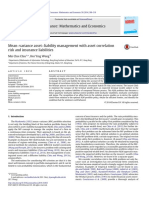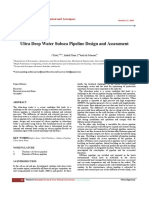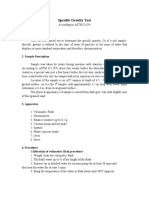Synergistic Catalysis by Lewis Acid and Base Sites On Zro For Meerwein Ponndorf Verley Reduction
Synergistic Catalysis by Lewis Acid and Base Sites On Zro For Meerwein Ponndorf Verley Reduction
Uploaded by
Riza SaidOriginal Title
Copyright
Available Formats
Share this document
Did you find this document useful?
Is this content inappropriate?
Report this DocumentCopyright:
Available Formats
Synergistic Catalysis by Lewis Acid and Base Sites On Zro For Meerwein Ponndorf Verley Reduction
Synergistic Catalysis by Lewis Acid and Base Sites On Zro For Meerwein Ponndorf Verley Reduction
Uploaded by
Riza SaidCopyright:
Available Formats
Article
pubs.acs.org/JPCC
Synergistic Catalysis by Lewis Acid and Base Sites on ZrO2 for
Meerwein−Ponndorf−Verley Reduction
Tasuku Komanoya,†,‡ Kiyotaka Nakajima,†,§ Masaaki Kitano,∥ and Michikazu Hara*,†,‡,⊥
†
Materials and Structures Laboratory, ‡Frontier Research Center, and ∥Materials Research Center for Element Strategy, Tokyo
Institute of Technology, Midori-ku, Yokohama 226-8503, Japan
§
Precursory Research for Embryonic Science and Technology (PRESTO) and ⊥Advanced Low Carbon Technology Research and
Development Program (ALCA), Japan Science and Technology Agency (JST), 4-1-8 Honcho, Kawaguchi 332-0012, Japan
*
S Supporting Information
ABSTRACT: Early transition metal oxides, TiO2, ZrO2, and Nb2O5,
were studied as heterogeneous catalysts for the Meerwein−
Ponndorf−Verley (MPV) reduction of cyclohexanone in 2-propanol.
Despite a small amount of Lewis acid sites and weak Lewis acid
strength, ZrO2 was clearly superior to TiO2 and Nb2O5 with respect
to reaction rate. Fourier transform infrared spectroscopy (FT-IR) and
temperature-programmed-desorption (TPD) measurements revealed
that ZrO2 has large amounts of base sites that activate the methylene
groups in 2-propanol bonded to Lewis acid sites. Various analyses,
including experiments using isotopic 2-propanol, suggest that
efficient MPV reduction over ZrO2 is due not only to Lewis acid
strength and density, but also to a synergistic effect of base and Lewis
acid sites.
1. INTRODUCTION surfaces, have a positive effect to increase the overall reaction
Meerwein−Ponndorf−Verley (MPV) reduction is a traditional rate.18,32−37 The role of base sites has been proposed to assist
redox technique through the intermolecular hydride transfer the formation of alkoxide species with Lewis acid sites by the
between ketone and alcohol,1,2 which enables carbonyl-selective deprotonation of alcohol molecules17,42 at the initial stage of
hydrogenation even in the presence of easily reduced groups, the reaction. However, no direct evidence has been reported so
such as halogens, nitriles, alkoxyl groups, and unsaturated far.
carbon moieties. Therefore, inter- and intramolecular MPV- Recently, we have reported that unsaturated coordination Nb
type hydrogen transfers have been widely applied to various
organic syntheses for the production of useful chemicals, and Ti species on their oxide surfaces can act as Lewis acid sites
especially in the fields of asymmetric synthesis3,4 and biomass in water.6,9,43,44 While certain amounts of undesirable by-
conversion.5−9 Since the first discovery of the MPV reduction products are simultaneously evolved over Nb2O5 and TiO2,
catalyzed by aluminum alkoxides,10−13 the use of solid catalysts they function as effective catalysts for the hydride transfer of
has been widely investigated,14−37 due to high durability and pyruvaldehyde into lactic acid in water.9 This hydride transfer
reusability, which are necessary for sustainable chemical reaction is considered to proceed on the Lewis acid sites via the
production.38 To date, an amphoteric oxide, represented by
MPV reduction mechanism.45 On the other hand, early
ZrO2,14−25 has been found to function as an efficient
heterogeneous catalyst for various MPV reactions. transition metal oxides, excluding ZrO 2, are generally
It is generally accepted that the metal center that acts as a considered not to be effective for typical intermolecular MPV
Lewis acid site facilitates the formation of a six-membered ring reduction, such as cyclohexanone with 2-propanol (2-PrOH).
transition state with ketones and alcohols to accomplish the However, TiO2 and Nb2O5 have similar Lewis acidity to ZrO2.
hydride transfer.39 The formation of the six-membered ring In this study, the roles of base and Lewis acid sites on
intermediate is regarded as the rate-determining step for MPV heterogeneous catalysts were investigated through the MPV
reduction.39 This concerted pathway is energetically favorable
compared to stepwise transfer hydrogenation involving β- reduction of cyclohexanone with 2-PrOH using ZrO2, TiO2,
hydride elimination of alcohols via the formation of metal and Nb2O5.
hydride species, which is typically observed over metallic Ru
and Ir catalysts.40,41 The reaction is largely dependent on Lewis Received: August 27, 2015
acid sites as catalytically active sites. In addition, weak base sites, Revised: November 8, 2015
such as hydroxyl groups on basic and amphoteric oxide Published: November 9, 2015
© 2015 American Chemical Society 26540 DOI: 10.1021/acs.jpcc.5b08355
J. Phys. Chem. C 2015, 119, 26540−26546
The Journal of Physical Chemistry C Article
2. EXPERIMENTAL SECTION 3. RESULTS AND DISCUSSION
2.1. Catalyst Preparation. A 10 g sample of zirconium Figure S1 shows XRD patterns and N2 adsorption−desorption
tetrapropoxide (70 wt % solution in 1-propanol, Aldrich) was isotherms for the ZrO2, Nb2O5, and TiO2 catalysts. ZrO2
added to 100 mL of distilled water at room temperature. After (surface area 42 m2 g−1) is a mixture of monoclinic and
the solution was stirred for 2 h, a white precipitate was collected tetragonal phases. The XRD pattern for TiO2 (120 m2 g−1) is
by filtration, washed with 2 L of distilled water, and dried at 373 assignable to anatase TiO2, and that for Nb2O5 (110 m2 g−1)
K for several hours. The dried sample was then calcined at 673 indicates no obvious structure. The N2 adsorption−desorption
K for 8 h in air to obtain ZrO2 powder. TiO2 was also prepared isotherms for ZrO2, Nb2O5, and TiO2 indicate that TiO2 and
Nb2O5 have mesoporous structures, which result in larger
by the sol−gel reaction of Ti(OiPr)4 (Kanto Chemical) as a Ti
surface areas than that for ZrO2 without a porous structure.
source in water. Commercially available Nb2O5 (Companhia Table 1 summarizes the activities of the tested catalysts for
Brasileira de Metallurgia e Mineraçaõ ) was utilized after the MPV reduction of cyclohexanone in 2-PrOH at 393 K for 2
calcination of the as-received oxide at 673 K for 8 h in an air
atmosphere. Table 1. Catalytic Conversion of Cyclohexanone to
2.2. Catalytic Reaction. A mixture of the catalyst Cyclohexanol in 2-PrOHa
(heterogeneous catalyst, 0.1 g; homogeneous catalyst, 10
μmol), cyclohexanone (0.16 mmol), and 2-PrOH (2 mL, entry catalyst convb (%) yieldc (%)
dried with MS4A) was stirred in a glass tube reactor at 363− 1 Nb2O5 14 10
393 K for several hours. The products in the resulting solution 2 TiO2 12 11
were analyzed using gas chromatography (GC; Shimadzu GC- 3 ZrO2 81 80
2014, flame ionization detector) with a DB-FFAP column (0.25 4d H2SO4 9 <1
mm × 30 m × 0.25 μm). Decane was used as an internal 5e N(CH2CH3)3 <1 <1
standard. Four types of deuterium-labeled 2-PrOH 6e Sc(OTf)3 >99 >99
a
((CH3)2CDOH (CIL), (CH3)2CHOD (Merck), Reagents and conditions: catalyst, 0.1 g; cyclohexanone, 0.16 mmol;
(CD3)2CHOH, and (CD3)2CDOD (Aldrich)) were also used 2-PrOH, 2 mL; temperature, 393 K; time; 2 h. bCyclohexanone
conversion. cCyclohexanol yield. dCatalyst amountl 5 μmol. eCatalyst
as substrates for the MPV reduction to study the reaction amount, 10 μmol.
mechanism with the tested oxides.
2.3. Catalyst Characterization. Powder X-ray diffraction
(XRD; Rigaku Ultima IV) was conducted using Cu Kα h. The results for H2SO4, N(CH2CH3)3, and Sc(OTf)3 catalysts
are also shown for comparison. No cyclohexanol formation was
radiation (40 kV, 40 mA). The patterns were compared with
observed over either H2SO4 or N(CH2CH3)3 (entries 4 and 5),
references in the Joint Committee for Powder Diffraction
which indicates that typical Brønsted and base catalysts are not
Standards (JCPDS) to determine their crystalline structure. N2 effective for MPV reduction. In contrast, Sc(OTf)3, a
adsorption−desorption isotherms (Quantachrome Nova- homogeneous Lewis acid catalyst, gave a high cyclohexanol
4200e) were measured at 77 K (0.050 ≤ p/p0 ≤ 0.995). yield of over 99% (entry 6). This can be attributed to the
Prior to measurements, the catalysts were pretreated at 423 K scandium metal center, which acts as a catalytically active site
for 1 h under vacuum to remove physisorbed water and gases. for the reduction of cyclohexanone via the MPV reduction
The isotherms were analyzed by the Brunauer−Emmett−Teller mechanism. Cyclohexanol yields for Nb2O5 and TiO2 reached
(BET) method in the range 0.050 ≤ p/p0 ≤ 0.300 to calculate only ca. 10%; nevertheless, the yield for amphoteric ZrO2
the specific surface area. Fourier transform infrared spectros- exceeded 80% (entries 1−3). ZrO2 is therefore a highly active
copy (FT-IR; Jasco FT-IR-6100) measurements were con- catalyst for the MPV reduction.14−25 The high catalytic
ducted with an extended KBr beam splitting device and a performance of Sc(OTf)3 for the reaction suggests that the
mercury cadmium telluride (MCT) detector. Self-supported catalytic activity is determined by the Lewis acid properties.
disks (20 mm diameter, ca. 20 mg) of the oxides were placed Lewis acid properties of ZrO2, Nb2O5, and TiO2 were
into an IR cell attached to a closed circulation system. Prior to evaluated by FT-IR measurement for samples with adsorbed
measurement, the disks were dried at 573 K for 1 h under pyridine or cyclohexanone as probe base molecules. Figures 1
vacuum to remove physisorbed water and gases. Pyridine, and 2 show FT-IR spectra for ZrO2, Nb2O5, and TiO2 with
cyclohexanone, and 2-PrOH were used as probe molecules for adsorbed pyridine and cyclohexanone, respectively. The
the characterization of acid and base sites in the catalysts.9 In amounts of Brønsted and Lewis acid sites can be estimated
the case of cyclohexanone and 2-PrOH adsorption, the sample from the FT-IR results for the catalysts with absorbed pyridine,
while those for the catalysts with absorbed cyclohexanone are
disk was exposed to saturated vapor (>4 kPa) at room
available for the estimation of acid site strength. The band at
temperature and was then evacuated to remove weakly
1445 cm−1 in the difference FT-IR spectra in Figure 1 is
physisorbed molecules. The obtained spectra were normalized assignable to coordinated pyridine species with Lewis acid
on the basis of the sample weight. CO2 temperature- sites.46 The band at 1540 cm−1 due to pyridinium ions bonded
programmed desorption (CO2-TPD; BEL Japan BELCAT-A) to Brønsted acid sites appears only in the spectrum for Nb2O5,
was performed at a heating rate of 10 K min−1 from 373 to and Brønsted acid sites are not effective for MPV reduction
1273 K under a He flow (30 mL min−1). After dehydration of (Table 1, entry 4). The amounts of Lewis acid sites on Nb2O5,
the samples at 673 K for 1 h under He flow, CO2 gas (5% CO2/ TiO2, and ZrO2 were estimated from the intensities of the band
He, 30 mL min−1) was contacted with the dehydrated samples 1445 cm−1 to be 0.15, 0.32, and 0.04 mmol g−1, respectively.
(50 mg) at 373 K for 0.5 h. Outlet gas was detected with a mass This indicates that ZrO2, which was highly active for the
analyzer (BEL Japan BELMass) (m/z = 44) to monitor reaction, has a much lower density of Lewis acid sites than
desorption of CO2 from the samples. Nb2O5 and TiO2. Figure 2 shows FT-IR spectra for Nb2O5,
26541 DOI: 10.1021/acs.jpcc.5b08355
J. Phys. Chem. C 2015, 119, 26540−26546
The Journal of Physical Chemistry C Article
Table 2. Acid−Base Properties and Kinetic Parameters of
Metal Oxides
amount of acid−
base
sites/mmol g−1
Lewis
acid base
catalyst sitesa sitesb kc/h−1 TOFd/h−1 Eae/kJ mol−1
Nb2O5 0.15 ND 0.058 ± 0.004 0.53 58 ± 3.2
TiO2 0.32 0.006 0.065 ± 0.004 0.28 67 ± 2.6
ZrO2 0.04 0.08 0.798 ± 0.049 27.3 51 ± 1.7
a
Amount of Lewis acid sites estimated from FT-IR measurement of
pyridine-adsorbed sample (Figure 1). bAmount of base sites estimated
from CO2-TPD measurement (Figure 4). cRate constant for
Figure 1. Difference FT-IR spectra of pyridine-adsorbed catalysts at cyclohexanol formation estimated with the assumption of pseudo-
298 K. Prior to measurements, the dehydrated samples were exposed first-order kinetics (Figure S2). Standard error of regression assuming
to saturated pyridine vapor and then evacuated at 298 K for 4 h to error was estimated with n − 1 degrees of freedom. dTurnover
remove weakly physisorbed pyridine. “B” and “L” denote Brønsted and frequency for cyclohexanol production in 30% yield based on Lewis
Lewis acids, respectively. acid sites. eApparent activation energy (Ea) estimated for the reaction
temperature from 363 to 393 K (Figure 3). Standard error of
regression assuming error was estimated with n − 2 degrees of
freedom. Reagents and conditions: catalyst, 100 mg; cyclohexanone,
0.16 mmol; 2-PrOH, 2 mL; temperature, 363, 373, 383, and 393 K.
Figure 2. Difference FT-IR spectra of cyclohexanone-adsorbed
catalysts at 323 K. Prior to measurements, the dehydrated samples
were exposed to saturated cyclohexanone vapor and then evacuated at
323 K to remove weakly physisorbed cyclohexanone.
Figure 3. Arrhenius plots for MPV reduction of cyclohexanone with 2-
PrOH over metal oxide catalysts.
TiO2, and ZrO2 with cyclohexanone adsorbed at 323 K. It has
been reported that the v(CO) band of cyclohexanone possible explanation for the results is high density of base sites
bonded to Lewis acid sites appears at 1700−1600 cm−1, and the on ZrO2, as shown in Table 2. Figure 4 shows CO2-TPD for
peak wavenumber decreases with an increase in the Lewis acid each sample. A large and broad CO2 desorption peak is
strength.31 The bands for Nb2O5, TiO2, and ZrO2 were observed in ZrO2, such a large peak does not appear in Nb2O5
observed at 1666, 1678, and 1686 cm−1, respectively. Thus, and TiO2, which indicates a high density of base sites on ZrO2.
ZrO2 is inferior to Nb2O5 and TiO2 in Lewis acid strength.
Although ZrO2 has a lower Lewis acid density and weaker
Lewis acid strength than Nb2O5 and TiO2, ZrO2 exhibits much
higher catalytic performance for the MPV reaction than these
oxides. Therefore, catalysis with ZrO2 cannot be explained only
by the acid site density and strength. Table 2 summarizes the
amounts of Lewis acid and base sites, the rate constant k, the
turnover frequency (TOF) based on the amount of Lewis acid
sites, and the apparent activation energy estimated from k. k
was obtained on the assumption of a pseudo-first-order
reaction.47 Figure 3 shows Arrhenius plots for Nb2O5, TiO2,
and ZrO2, which indicate that there are no significant
differences in the apparent activation energies among the
tested samples. In addition, the Arrhenius plot for ZrO2
indicates a much larger value for ln k than those for Nb2O5
and TiO2, which suggests that the high catalytic activity of ZrO2
for the reaction can be attributed to the entropy term rather
than the enthalpy term, apparent activation energy. One Figure 4. CO2-TPD profiles of the catalysts.
26542 DOI: 10.1021/acs.jpcc.5b08355
J. Phys. Chem. C 2015, 119, 26540−26546
The Journal of Physical Chemistry C Article
The amounts of base sites estimated from the CO2-TPD results
are also shown in Table 2; ZrO2 has a much larger amount of
base sites than Nb2O5 and TiO2. The Lewis acid and base sites
densities for ZrO2, which were calculated on the basis of the
BET surface area, were 0.57 and 1.1 nm−2, respectively. Taking
into account the molecular sizes of cyclohexanone and 2-
propanol (0.75 and 0.34 nm), it is expected that both acid and
base sites can interact with reactant molecules. A synergistic
effect of acid−base sites is thus considered to occur with ZrO2.
CHCl3 was used as a probe molecule for IR measurements to
evaluate the correlation of base sites with Lewis acid sites.48,49
Difference FT-IR spectra for the CHCl3-adsorbed catalysts are
shown in Figure 5. The hydrogen-bonding interaction of the
Figure 6. Difference FT-IR spectra of 2-PrOH-adsorbed catalysts at
298 K. Before measurement, the dehydrated samples were exposed
with saturated 2-PrOH vapor and then evacuated at 298 K to remove
weakly physisorbed 2-PrOH molecules.
v(CH) among the samples. However, the vas(CH3) band in the
spectrum for ZrO2 was clearly red-shifted, compared with those
for Nb2O5 and TiO2; the vas(CH3) bands for ZrO2, TiO2, and
Nb2O5 appear at 2964, 2972, and 2975 cm−1, respectively. This
red shift of the vas(CH3) band is due to the interaction of
slightly acidic methyl hydrogen atoms in isopropoxide with the
Figure 5. Difference FT-IR spectra of CHCl3-adsorbed catalysts in the base sites, which suggests that this relates to the reaction. A
region of the (a) stretching and (b) bending modes at 298 K with
gaseous CHCl3 at 2.9 × 10−1 kPa.
similar interaction of the base sites with methyl hydrogen in 2-
PrOH was also observed in the conversion to propylene, which
enhances the C−O elimination step in the dehydration reaction
acidic hydrogen in CHCl3 molecules with base sites results in a via the substitution of methyl hydrogen by the base (E1cB
red shift of the original C−H stretching mode.48 While no mechanism).51 If this phenomenon enhanced β-H elimination,
significant change of the original CH stretching mode is v(CH) due to β-H of 2-PrOH would be largely red-shifted with
observed for Nb2O5, the bands for TiO2 and ZrO2 appear at a decrease in apparent activation energy. There is no large
3006 and 2994 cm−1, respectively (Figure 5a). This difference is difference in apparent activation energy for the MPV reduction
due to the presence of base sites on the surface, which is among ZrO2, TiO2, and Nb2O5 as shown in Table 2. This
consistent with the CO2-TPD measurement results. In addition, supports that the reaction does not depend largely on the
CH stretching for ZrO2 appears at a lower wavelength (2994 interaction of slightly acidic methyl hydrogen atoms in
cm−1) than that of TiO2, meaning a stronger effect of base sites isopropoxide with the base sites. These results imply that β-
on ZrO2. Furthermore, the original band for the HC−Cl H elimination, the rate-determining step of the reaction,
bending mode at 1219 cm−1 splits after adsorption on ZrO2 and proceeds on the Lewis acid sites and the base sites contribute
TiO2. A new broad shoulder band that appears at 1250 cm−1 is only to an increase in the frequency factor, i.e., the entropy
attributed to δ(ClC−H) for CHCl3 molecules due to term in the Arrhenius equation. If the amount of adsorbed 2-
interaction of the acidic hydrogen and chlorine atom with PrOH were in proportion only to the amount of Lewis acid
basic oxygen and Lewis acid sites, respectively (Figure 5b).49 sites on each sample, the intensities of IR spectra for 2-PrOH
The molecular cross section of CHCl3 is 0.30 nm2.50 As a adsorbed Nb2O5 and TiO2 would exceed 3 times that of ZrO2
result, the base sites on ZrO2 could be located in close in Figure 6, because Nb2O5 and TiO2 have much larger
proximity to the Lewis acid sites, which enables simultaneous amounts of Lewis acid sites (0.15 and 0.32 mmol g−1) than
activation of such a small-sized molecule with both Lewis acid ZrO2 (0.04 mmol g−1). However, there is no such large
and base sites. A base catalyst alone cannot promote the MPV difference in intensity among the spectra of 2-PrOH adsorbed
reduction, as shown in Table 1. However, the different activities Nb2O5, TiO2, and ZrO2, suggesting that the base sites increase
among the tested catalysts indicate that base sites clearly have a 2-PrOH adsorption on ZrO2. This may contribute to an
positive effect on the MPV reduction. increase in the frequency factor, resulting in high catalytic
FT-IR spectra of 2-PrOH-adsorbed samples were measured performance for the MPV reduction over ZrO2.
to clarify the role of the base sites on ZrO2 for MPV reduction The role of base sites for the activation of 2-PrOH was
(Figure 6). After dehydration at 573 K for 1 h, the sample disk further investigated through the kinetic isotope effect (KIE) in
was exposed to saturated 2-PrOH vapor, followed by the MPV reduction of cyclohexanone with various deuterated
evacuation at 323 K. Because base sites preferentially interact 2-PrOH (Figure 7) systems. In the case of (CH3)2CHOD, no
with slightly acidic CH groups in 2-PrOH, the changes in the KIE was observed (2-PrOD; kH/kD = 1.1). In contrast,
original CH stretching modes (v(CH), vs(CH3), and vas(CH3)) (CH3)2CDOH gave a large kH/kD of 1.9, which is consistent
after 2-PrOH adsorption on the solid catalyst surface are with the previous report, where β-H elimination during the
available to evaluate the relationship between the base sites and formation of the six-membered transition state is accepted as
2-PrOH. There were no large differences in vs(CH3) and the rate-determining step for MPV reduction.14,39 kH/kD values
26543 DOI: 10.1021/acs.jpcc.5b08355
J. Phys. Chem. C 2015, 119, 26540−26546
The Journal of Physical Chemistry C Article
4. CONCLUSIONS
Amphoteric ZrO2 exhibited excellent catalytic activity for the
MPV reduction of cyclohexanone in 2-PrOH, where the
reaction rate for ZrO2 was more than 10 times that for Nb2O5
and TiO2. Kinetic analyses and characterization of these
catalysts demonstrated that the high catalytic performance of
ZrO2 for MPV reduction is not due to the strength and density
of Lewis acid sites, but to a high density of base sites on ZrO2.
FT-IR studies using various probe molecules and isotope
experiments revealed that base sites on ZrO2 play an important
role for the formation of six-membered intermediates on Lewis
acid sites. In the cases of Nb2O5 and TiO2 with no and poor
Figure 7. Kinetic isotope effects for MPV reduction of cyclohexanone basicity, respectively, the reaction proceeds only on Lewis acid
with deuterated 2-PrOH using ZrO2 catalyst. sites, which results in poor catalysis. These results clearly
demonstrate that the synergistic catalysis involving acid−base
for (CD3)2CHOH and (CD3)2CDOD were estimated to be 1.3 sites leads to an efficient MPV-type transfer hydrogenation
and 2.2, respectively, which are slightly larger than kH/kD ratios reaction.
for 2-PrOD (kH/kD = 1.1) and (CH3)2CDOH (kH/kD = 1.9).
The interaction of base sites with −CH3 groups may, in part,
participate in the MPV reduction.
■
*
ASSOCIATED CONTENT
S Supporting Information
To summarize the foregoing results, a proposed reaction The Supporting Information is available free of charge on the
mechanism is shown in Scheme 1. Lewis acid sites adsorb ACS Publications website at DOI: 10.1021/acs.jpcc.5b08355.
XRD patterns and N2 adsorption−desorption isotherms
Scheme 1. Plausible Reaction Pathway for MPV Reduction of metal oxide catalysts (Figure S1); time courses of
of Cyclohexanone with 2-PrOH over ZrO2 Catalyst via MPV reduction of cyclohexanone with 2-PrOH over
Acid−Base Concerted Mechanism
metal oxide catalysts (Figure S2) (PDF)
■ AUTHOR INFORMATION
Corresponding Author
*E-mail: mhara@msl.titech.ac.jp.
Present Address
K.N.: Institute for Catalysis, Hokkaido University, Kita 21 Nishi
10, Sapporo 001-0021, Japan.
Author Contributions
The manuscript was written through contributions of all
authors. All authors have given approval to the final version of
the manuscript.
Notes
The authors declare no competing financial interest.
■ ACKNOWLEDGMENTS
This work was supported in part by the Novel Cheap and
Abundant Materials for Catalytic Biomass Conversion
(NOVACAM, FP7-NMP-2013-EU-Japan-604319) program of
the Japan Science and Technology Agency (JST) and the
European Commission Directorate-General for Research and
Innovation.
cyclohexanone, and 2-PrOH is adsorbed as isopropoxide
through base sites derived from hydroxyl groups on the ZrO2
surface. The density of base sites on ZrO2 is much higher than
■ REFERENCES
(1) Cha, J. S. Recent Developments in Meerwein-Ponndorf-Verley
and Related Reactions for the Reduction of Organic Functional
those of TiO2 and Nb2O5. This facilitates the formation of a six- Groups Using Aluminum, Boron, and Other Metal Reagents: A
membered ring transition state with ketones and alcohols, Review. Org. Process Res. Dev. 2006, 10, 1032−1053.
resulting in hydride transfer through β-H elimination. While the (2) Chuah, G. K.; Jaenicke, S.; Zhu, Y. Z.; Liu, S. H. Meerwein-
Ponndorf-Verley Reduction over Heterogeneous Catalysts. Curr. Org.
MPV reduction seems to depend largely on Lewis acid density Chem. 2006, 10, 1639−1654.
and strength as seen in the reaction by Sc(OTf)3 (Table 1), the (3) Nishide, K.; Node, M. Recent Development of Asymmetric
effect due to base site density exceeds that of Lewis acid density Syntheses Based on the Meerwein-Ponndorf-Verley Reduction.
and strength. ZrO2 therefore exhibits a much higher catalytic Chirality 2002, 14, 759−767.
(4) Wu, X.; Xiao, J. Aqueous-Phase Asymmetric Transfer Hydro-
performance for the reaction, despite lower Lewis acid density genation of Ketones − a Greener Approach to Chiral Alcohols. Chem.
and strength, than TiO2 and Nb2O5. Commun. 2007, 24, 2449−2466.
26544 DOI: 10.1021/acs.jpcc.5b08355
J. Phys. Chem. C 2015, 119, 26540−26546
The Journal of Physical Chemistry C Article
(5) Román-Leshkov, Y.; Moliner, M.; Labinger, J. A.; Davis, M. E. (26) Creyghton, E. J.; Ganeshie, S. D.; Downing, R. S.; van Bekkum,
Mechanism of Glucose Isomerization Using a Solid Lewis Acid H. Stereoselective Meerwein-Ponndorf-Verley and Oppenauer Re-
Catalyst in Water. Angew. Chem., Int. Ed. 2010, 49, 8954−8957. actions Catalysed by Zeolite BEA. J. Mol. Catal. A: Chem. 1997, 115,
(6) Nakajima, K.; Baba, Y.; Noma, R.; Kitano, M.; Kondo, J. N.; 457−472.
Hayashi, S.; Hara, M. Nb2O5·nH2O as a Heterogeneous Catalyst with (27) Kunkeler, P. J.; Zuurdeeg, B. J.; van der Waal, J. C.; van
Water-Tolerant Lewis Acid Sites. J. Am. Chem. Soc. 2011, 133, 4224− Bokhoven, J. A.; Koningsberger, D. C.; van Bekkum, H. Zeolite Beta:
4227. The Relationship between Calcination Procedure, Aluminum Config-
(7) Chia, M.; Dumesic, J. A. Liquid-Phase Catalytic Transfer uration, and Lewis Acidity. J. Catal. 1998, 180, 234−244.
Hydrogenation and Cyclization of Levulinic Acid and its Esters to γ- (28) Anwander, R.; Palm, C.; Gerstberger, G.; Groeger, O.;
Valerolactone over Metal Oxide Catalysts. Chem. Commun. 2011, 47, Engelhardt, G. Enhanced Catalytic Activity of MCM-41-Grafted
12233−12235. Aluminium Isopropoxide in MPV Reductions. Chem. Commun.
(8) Bui, L.; Luo, H.; Gunther, W. R.; Román-Leshkov, Y. Domino 1998, 17, 1811−1812.
Reaction Catalyzed by Zeolites with Brønsted and Lewis Acid Sites for (29) Shylesh, S.; Kapoor, M. P.; Juneja, L. R.; Samuel, P. P.;
the Production of γ-Valerolactone from Furfural. Angew. Chem. 2013, Srilakshmi, C.; Singh, A. P. Catalytic Meerwein-Ponndorf-Verley
125, 8180−8183. Reductions over Mesoporous Silica Supports: Rational Design of
(9) Nakajima, K.; Noma, R.; Kitano, M.; Hara, M. Titania as an Early Hydrophobic Mesoporous Silica for Enhanced Stability of Aluminum
Transition Metal Oxide with a High Density of Lewis Acid Sites Doped Mesoporous Catalysts. J. Mol. Catal. A: Chem. 2009, 301, 118−
Workable in Water. J. Phys. Chem. C 2013, 117, 16028−16033. 126.
(10) Meerwein, H.; Schmidt, R. Ein Neues Verfahren zur Reduktion (30) Uysal, B.; Oksal, B. S. Comparison of Heterogeneous B(OiPr)3-
von Aldehyden und Ketonen. Liebigs Ann. Chem. 1925, 444, 221−238. MCM-41 and Homogeneous B(OiPr)3, B(OEt)3 Catalysts for
(11) Ponndorf, W. Der Reversible Austausch der Oxydationsstufen Chemoselective MPV Reductions of Unsaturated Aldehydes and
zwischen Aldehyden oder Ketonen Einerseits und Primären oder Ketones. Appl. Catal., A 2012, 435−436, 204−216.
Sekundären Alkoholen Anderseits. Angew. Chem. 1926, 39, 138−143. (31) Corma, A.; Domine, M. E.; Valencia, S. Water-Resistant Solid
(12) Verley, A. Exchange of Functional Groups between Two Lewis Acid Catalysts: Meerwein-Ponndorf-Verley and Oppenauer
Molecules. Exchange of Alcohol and Aldehyde Groups. Bull. Soc. Chim. Reactions Catalyzed by Tin-Beta Zeolite. J. Catal. 2003, 215, 294−304.
Fr. 1925, 37, 537−542. (32) Lopez, J.; Valente, J. S.; Clacens, J.-M.; Figueras, F. Hydrogen
(13) Verley, A. The Exchange of Functional Groups between Two Transfer Reduction of 4-tert-Butylcyclohexanone and Aldol Con-
Molecules. The Passage of Ketones to Alcohols and the Reverse. Bull. densation of Benzaldehyde with Acetophenone on Basic Solids. J.
Soc. Chim. Fr. 1925, 37, 871−874. Catal. 2002, 208, 30−37.
(14) Shibagaki, M.; Takahashi, K.; Matsushita, H. The Catalytic (33) Aramendía, M. A.; Borau, V.; Jiménez, C.; Marinas, J. M.; Ruiz,
Reduction of Aldehydes and Ketones with 2-Propanol over Hydrous J. R.; Urbano, F. J. Influence of the Preparation Method on the
Structural and Surface Properties of Various Magnesium Oxides and
Zirconium Oxide. Bull. Chem. Soc. Jpn. 1988, 61, 3283−3288.
their Catalytic Activity in the Meerwein-Ponndorf-Verley Reaction.
(15) Takahashi, K.; Shibagaki, M.; Kuno, H.; Matsushita, H.
Appl. Catal., A 2003, 244, 207−215.
Reduction of Carboxylic Acid with 2-Propanol over Hydrous
(34) Axpuac, S.; Aramendía, M. A.; Hidalgo-Carrillo, J.; Marinas, A.;
Zirconium Oxide. Chem. Lett. 1989, 18, 1141−1144.
Marinas, J. M.; Montes-Jiménez, V.; Urbano, F. J.; Borau, V. Study of
(16) Gargano, M.; D’Orazio, V.; Ravasio, N.; Rossi, M. Selective
Structure-Performance Relationships in Meerwein-Ponndorf-Verley
Preparation of Unsaturated Alcohols via Catalytic Meerwein-Ponndorf
Reduction of Crotonaldehyde on Several Magnesium and Zirconium-
Reduction of Unsaturated Carbonyl Compounds over Metal Oxides. J.
Based Systems. Catal. Today 2012, 187, 183−190.
Mol. Catal. 1990, 58, L5−L8. (35) Kumbhar, P. S.; Sanchez-Valente, J.; Lopez, J.; Figueras, F.
(17) Ivanov, V. A.; Bachelier, J.; Audry, F.; Lavalley, J. C. Study of the Meerwein-Ponndorf-Verley Reduction of Carbonyl Compounds
Meerwein-Ponndorf-Verley Reaction between Ethanol and Acetone Catalysed by Mg-Al Hydrotalcite. Chem. Commun. 1998, 5, 535−536.
on Various Metal Oxides. J. Mol. Catal. 1994, 91, 45−59. (36) Jiménez-Sanchidrián, C.; Hidalgo, J. M.; Ruiz, J. R. Reduction of
(18) Zhu, Y.; Liu, S.; Jaenicke, S.; Chuah, G. Zirconia Catalysts in Heterocyclic Carboxaldehydes via Meerwein-Ponndorf-Verley Reac-
Meerwein-Ponndorf-Verley Reduction of Citral. Catal. Today 2004, tion. Appl. Catal., A 2006, 303, 23−28.
97, 249−255. (37) Radhakrishan, R.; Do, D. M.; Jaenicke, S.; Sasson, Y.; Chuah, G.-
(19) Jaenicke, S.; Chuah, G. K.; Raju, V.; Nie, Y. T. Structural and K. Potassium Phosphate as a Solid Base Catalyst for the Catalytic
Morphological Control in the Preparation of High Surface Area Transfer Hydrogenation of Aldehydes and Ketones. ACS Catal. 2011,
Zirconia. Catal. Surv. Asia 2008, 12, 153−169. 1, 1631−1636.
(20) Zhu, Y.; Jaenicke, S.; Chuah, G. K. Supported Zirconium (38) Climent, M. J.; Corma, A.; Iborra, S. Heterogeneous Catalysts
Propoxidea Versatile Heterogeneous Catalyst for the Meerwein− for the One-Pot Synthesis of Chemicals and Fine Chemicals. Chem.
Ponndorf−Verley Reduction. J. Catal. 2003, 218, 396−404. Rev. 2011, 111, 1072−1133.
(21) De Bruyn, M.; Limbourg, M.; Denayer, J.; Baron, G. V.; (39) Cohen, R.; Graves, C. R.; Nguyen, S. T.; Martin, J. M. L.;
Parvulescu, V.; Grobet, P. J.; De Vos, D. E.; Jacobs, P. A. Mesoporous Ratner, M. A. The Mechanism of Aluminum-Catalyzed Meerwein-
Zr and Hf Catalysts for Chemoselective MPV Reductions of Schmidt-Ponndorf-Verley Reduction of Carbonyls to Alcohols. J. Am.
Unsaturated Ketones. Appl. Catal., A 2003, 254, 189−201. Chem. Soc. 2004, 126, 14796−14803.
(22) Zhu, Y.; Chuah, G.; Jaenicke, S. Al-free Zr-zeolite Beta as a (40) Zassinovich, G.; Mestroni, G.; Gladiali, S. Asymmetric
Regioselective Catalyst in the Meerwein−Ponndorf−Verley Reaction. Hydrogen Transfer Reactions Promoted by Homogeneous Transition
Chem. Commun. 2003, 21, 2734−2735. Metal Catalysts. Chem. Rev. 1992, 92, 1051−1069.
(23) Zhu, Y.; Chuah, G.; Jaenicke, S. Chemo- and Regioselective (41) Yamaguchi, K.; Koike, T.; Kotani, M.; Matsushita, M.; Shinachi,
Meerwein-Ponndorf-Verley and Oppenauer Reactions Catalyzed by S.; Mizuno, N. Synthetic Scope and Mechanistic Studies of Ru(OH)x/
Al-Free Zr-Zeolite Beta. J. Catal. 2004, 227, 1−10. Al2O3-Catalyzed Heterogeneous Hydrogen-Transfer Reactions. Chem.
(24) Ramanathan, A.; Castro Villalobos, M. C.; Kwakernaak, C.; - Eur. J. 2005, 11, 6574−6582.
Telalovic, S.; Hanefeld, U. Zr-TUD-1: A Lewis Acidic, Three- (42) Boronat, M.; Corma, A.; Renz, M. Mechanism of the Meerwein-
Dimensional, Mesoporous, Zirconium-Containing Catalyst. Chem. - Ponndorf-Verley-Oppenauer (MPVO) Redox Equilibrium on Sn- and
Eur. J. 2008, 14, 961−972. Zr-Beta Zeolite Catalysts. J. Phys. Chem. B 2006, 110, 21168−21174.
(25) Telalović, S.; Ng, J. F.; Maheswari, R.; Ramanathan, A.; Chuah, (43) Shintaku, H.; Nakajima, K.; Kitano, M.; Ichikuni, N.; Hara, M.
G. K.; Hanefeld, U. Synergy between Brønsted Acid Sites and Lewis Lewis Acid Catalysis of TiO4 Tetrahedra on Mesoporous Silica in
Acid Sites. Chem. Commun. 2008, 38, 4631−4633. Water. ACS Catal. 2014, 4, 1198−1204.
26545 DOI: 10.1021/acs.jpcc.5b08355
J. Phys. Chem. C 2015, 119, 26540−26546
The Journal of Physical Chemistry C Article
(44) Shintaku, H.; Nakajima, K.; Kitano, M.; Hara, M. Efficient
Mukaiyama Aldol Reaction in Water with TiO4 Tetrahedra on a
Hydrophobic Mesoporous Silica Surface. Chem. Commun. 2014, 50,
13473−13476.
(45) Koito, Y.; Nakajima, K.; Kitano, M.; Hara, M. Efficient
Conversion of Pyruvic Aldehyde into Lactic Acid by Lewis Acid
Catalyst in Water. Chem. Lett. 2013, 42, 873−875.
(46) Parry, E. P. An Infrared Study of Pyridine Adsorbed on Acidic
Solids. Characterization of Surface Acidity. J. Catal. 1963, 2, 371−379.
(47) Ruiz, J. R.; Jiménez-Sanchidrián, C.; Hidalgo, J. M. Meerwein-
Ponndorf-Verley Reaction of Acetophenones with 2-Propanol over
MgAl Mixed Oxide: The Substituent Effect. Catal. Commun. 2007, 8,
1036−1040.
(48) Xie, J.; Huang, M.; Kaliaguine, S. Zeolite Basicity Characterized
by Chloroform Chemisorption: An Infrared Study. React. Kinet. Catal.
Lett. 1996, 58, 217−227.
(49) Huber, S.; Knözinger, H. Adsorption of CH-Acids on Magnesia.
An FTIR-Spectroscopic Study. J. Mol. Catal. A: Chem. 1999, 141,
117−127.
(50) Bah, A.; Ceva, T.; Croset, B.; Dupont-Pavlovsky, N.; Ressouche,
E. Structural Study of a Chloroform Film Adsorbed on Graphite. Surf.
Sci. 1998, 395, 307−316.
(51) Díez, V. K.; Apesteguía, C. R.; Cosimo, J. I. D. Acid-Base
Properties and Active Site Requirements for Elimination Reactions on
Alkali-Promoted MgO Catalysts. Catal. Today 2000, 63, 53−62.
26546 DOI: 10.1021/acs.jpcc.5b08355
J. Phys. Chem. C 2015, 119, 26540−26546
You might also like
- TDP-102 ABCs of ComfortDocument71 pagesTDP-102 ABCs of ComfortErwin Maldo75% (4)
- Zhao 2004Document7 pagesZhao 200463011273No ratings yet
- Effect of Different Potassium Species On The Deactivation of V2O5-WO3/TiO2 SCR Catalyst: Comparison of K2SO4, KCL and K2ODocument7 pagesEffect of Different Potassium Species On The Deactivation of V2O5-WO3/TiO2 SCR Catalyst: Comparison of K2SO4, KCL and K2OLilyNo ratings yet
- Mo2C-HYDocument11 pagesMo2C-HYioanaandra5690No ratings yet
- 1 s2.0 S1566736717301425 MainDocument5 pages1 s2.0 S1566736717301425 MainAnonymous Wcj4C3jNo ratings yet
- Hydrogenation and Ring Opening of Naphthalene On Bulk and Supported Mo C CatalystsDocument11 pagesHydrogenation and Ring Opening of Naphthalene On Bulk and Supported Mo C Catalystsioanaandra5690No ratings yet
- Applied Catalysis B: EnvironmentalDocument9 pagesApplied Catalysis B: EnvironmentalElson OliveiraNo ratings yet
- Suhawati 2015 Chemical Degradation NaturalDocument12 pagesSuhawati 2015 Chemical Degradation Naturalfadhillah ivanNo ratings yet
- Karski 2003Document5 pagesKarski 2003farah al-sudaniNo ratings yet
- Zhou 2016 Effect of Basicity On The CatalyticDocument26 pagesZhou 2016 Effect of Basicity On The CatalyticElisabeta StamateNo ratings yet
- Ni Catalysts Derived From Mgeal Layered Double Hydroxides For Hydrogen Production From Landfill Gas ConversionDocument7 pagesNi Catalysts Derived From Mgeal Layered Double Hydroxides For Hydrogen Production From Landfill Gas Conversionjaimeo_07No ratings yet
- Selective Hydrogenation of 2-Ethylanthraquinone Over An Environmentally Benign Ni-B/SBA-15 Catalyst Prepared by A Novel Reductant-Impregnation MethodDocument4 pagesSelective Hydrogenation of 2-Ethylanthraquinone Over An Environmentally Benign Ni-B/SBA-15 Catalyst Prepared by A Novel Reductant-Impregnation Methodrizanda93No ratings yet
- Yu-Xie-Synthesis and Characterization of Monodispersed CopperDocument6 pagesYu-Xie-Synthesis and Characterization of Monodispersed CopperrobertsalazarruizNo ratings yet
- Jave PDFDocument10 pagesJave PDFjaveria tahirNo ratings yet
- Course: Heterogenous Reaction Systems Topic: Heterogeneous Ag-Tio - Sio Composite Materials As Novel Catalytic Systems For Selective Epoxidation of Cyclohexene by H ODocument17 pagesCourse: Heterogenous Reaction Systems Topic: Heterogeneous Ag-Tio - Sio Composite Materials As Novel Catalytic Systems For Selective Epoxidation of Cyclohexene by H OParidhi GargNo ratings yet
- 1 s2.0 S1743967122001192 MainDocument11 pages1 s2.0 S1743967122001192 MainIsraelPala-RosasNo ratings yet
- Zhang 2014Document5 pagesZhang 2014oviabeautyNo ratings yet
- ZNCDS NiAl Hydrotalcite S Scheme Heterojunction Fo 2022 International JournaDocument13 pagesZNCDS NiAl Hydrotalcite S Scheme Heterojunction Fo 2022 International JournaPrashant HNo ratings yet
- AR20170109Document5 pagesAR20170109maurinomjjNo ratings yet
- Active Sites of Ni2PSiO2 Catalyst For Hydrodeoxygenation of Guaiacol A Joint XAFS and DFT Study PDFDocument9 pagesActive Sites of Ni2PSiO2 Catalyst For Hydrodeoxygenation of Guaiacol A Joint XAFS and DFT Study PDFblackjack_027No ratings yet
- Chalcogenides: Photocatalytic Ability of ChalcogenidesDocument34 pagesChalcogenides: Photocatalytic Ability of ChalcogenidesNimisha G NairNo ratings yet
- Tin (II) Hydroxy Chloride - Heterogeneous Catalyst For Condensation ReactionDocument6 pagesTin (II) Hydroxy Chloride - Heterogeneous Catalyst For Condensation ReactionVijaykumar MarakattiNo ratings yet
- Methane Steam ReformingDocument8 pagesMethane Steam ReformingPanda BoyNo ratings yet
- V O - Smvo Mechanical Mixture: Oxidative Dehydrogenation of PropaneDocument11 pagesV O - Smvo Mechanical Mixture: Oxidative Dehydrogenation of PropaneRebeca CristinaNo ratings yet
- IR Ni LanthanaDocument6 pagesIR Ni LanthanaNelly RojasNo ratings yet
- Dinamarca 2016Document9 pagesDinamarca 2016progas.ukraineNo ratings yet
- s0926 860x2900051 0Document15 pagess0926 860x2900051 0macatl omarNo ratings yet
- Doi 10.1016 J.micromeso.2007.06.015Document8 pagesDoi 10.1016 J.micromeso.2007.06.015bruno barrosNo ratings yet
- Fischer Tropsch Synthesis Using Co/Sio Catalysts Prepared From Mixed Precursors and Addition Effect of Noble MetalsDocument9 pagesFischer Tropsch Synthesis Using Co/Sio Catalysts Prepared From Mixed Precursors and Addition Effect of Noble MetalsAlhassan NasserNo ratings yet
- Effects of Synthesis Conditions On The Structural and Electrochemical PropertiesDocument5 pagesEffects of Synthesis Conditions On The Structural and Electrochemical PropertiesjoseNo ratings yet
- H2 SCR To ReplicateDocument8 pagesH2 SCR To ReplicatemarviNo ratings yet
- The Effect of Doping Transition Metal Oxides On Copper Manganese Oxides For The Catalytic Oxidation of CODocument6 pagesThe Effect of Doping Transition Metal Oxides On Copper Manganese Oxides For The Catalytic Oxidation of COsid salmanNo ratings yet
- Synthesis of Palladium-Coated Magnetic Nanoparticle and Its Application in Heck ReactionDocument6 pagesSynthesis of Palladium-Coated Magnetic Nanoparticle and Its Application in Heck Reactionapi-3773399No ratings yet
- Kci Fi001467849Document5 pagesKci Fi001467849Valeria ChacónNo ratings yet
- 2015 (In Water Homocoupling of Arylboronic Acids Using Nano-Rod Shaped and Reusable Copper Oxide (II) Catalyst at Room Temperature)Document5 pages2015 (In Water Homocoupling of Arylboronic Acids Using Nano-Rod Shaped and Reusable Copper Oxide (II) Catalyst at Room Temperature)Hawta AbdullaNo ratings yet
- JPC 2014Document8 pagesJPC 2014Danesh AzNo ratings yet
- Dissolution of Iron Oxides by Oxalic Acid: Sung Oh LeeDocument229 pagesDissolution of Iron Oxides by Oxalic Acid: Sung Oh LeefhtgerthrgergNo ratings yet
- 2 AcetonitrileDocument7 pages2 Acetonitrilelimbachiya dakshNo ratings yet
- Li 2015Document9 pagesLi 2015Helder LucenaNo ratings yet
- 10.23 A Study On Adsorption Onto TODGA Resin After Electrolytic Reduction in ERIX Process For Reprocessing Spent FBR-MOX FuelDocument6 pages10.23 A Study On Adsorption Onto TODGA Resin After Electrolytic Reduction in ERIX Process For Reprocessing Spent FBR-MOX FuelPiter ColumboNo ratings yet
- 602-Article Text-5769-3-10-20150204Document8 pages602-Article Text-5769-3-10-20150204Arrei x5No ratings yet
- Applied Catalysis A: General: Sukriti Singh, Anjali Patel, Pravya PrakashanDocument10 pagesApplied Catalysis A: General: Sukriti Singh, Anjali Patel, Pravya PrakashanValentina Vargas VargasNo ratings yet
- Oxidation Reactions Using Tert-Butyl Hydroperoxide/d-Metal Chlorides Systems With Aid of MicrowavesDocument4 pagesOxidation Reactions Using Tert-Butyl Hydroperoxide/d-Metal Chlorides Systems With Aid of MicrowavessyaNo ratings yet
- 2010 - Preparation of Nanocrystalline Lithium Niobate Powders at Low TemperatureDocument6 pages2010 - Preparation of Nanocrystalline Lithium Niobate Powders at Low Temperature13408169705No ratings yet
- Cu-ZrO2 Catalysts With Highly Dispersed Cu Nanoclusters Derived FromDocument13 pagesCu-ZrO2 Catalysts With Highly Dispersed Cu Nanoclusters Derived FromPragadeesh SekarNo ratings yet
- Catalytic Oxidation of NO To NO2 For Nitric Acid Production Over A Pt-Al2O3Document5 pagesCatalytic Oxidation of NO To NO2 For Nitric Acid Production Over A Pt-Al2O3AnanthakishnanNo ratings yet
- Vanga Manocci ViscardiDocument6 pagesVanga Manocci Viscardieeajmal.cmdNo ratings yet
- Hydrogenolysis of Glycerol To 1,2-PropanediolDocument5 pagesHydrogenolysis of Glycerol To 1,2-PropanediolKesavan GovinathanNo ratings yet
- h2 O2 ProductionDocument9 pagesh2 O2 ProductionVaibhav ChaudharyNo ratings yet
- SCR - of-NO-by NH3-on-ironoxide-catalystDocument11 pagesSCR - of-NO-by NH3-on-ironoxide-catalystjosephweeraratneNo ratings yet
- Precipitation of Zirconium and Molybdenum in Simulated High-Level Liquid Waste Concentration and Denitration ProcessDocument6 pagesPrecipitation of Zirconium and Molybdenum in Simulated High-Level Liquid Waste Concentration and Denitration ProcessggulsuNo ratings yet
- Chemical Engineering Journal: Bholu Ram Yadav, Anurag GargDocument9 pagesChemical Engineering Journal: Bholu Ram Yadav, Anurag GargGaneshbhoiteNo ratings yet
- Steam Reforming of Acetic Acid Over Ni/Zro Catalysts: Effects of Nickel Loading and Particle Size On Product Distribution and Coke FormationDocument9 pagesSteam Reforming of Acetic Acid Over Ni/Zro Catalysts: Effects of Nickel Loading and Particle Size On Product Distribution and Coke Formationsum74316No ratings yet
- Catalytic Reduction of Nitrates and Nitrites in Water Solution On Pumice-Supported Pd-Cu CatalystsDocument9 pagesCatalytic Reduction of Nitrates and Nitrites in Water Solution On Pumice-Supported Pd-Cu CatalystsMarioNo ratings yet
- 1 s2.0 S0920586117302213 MainDocument11 pages1 s2.0 S0920586117302213 MainClaudia Elizabeth Ruiz DávilaNo ratings yet
- K5Pw11Nio39-Catalyzed Oxidation of Benzyl Alcohol With Hydrogen PeroxideDocument9 pagesK5Pw11Nio39-Catalyzed Oxidation of Benzyl Alcohol With Hydrogen PeroxideValentina Vargas VargasNo ratings yet
- 1 s2.0 S0926337322008992 MainDocument11 pages1 s2.0 S0926337322008992 MainAlbanny PerezNo ratings yet
- Acs OmegaDocument15 pagesAcs OmegaRajendra Nath MitraNo ratings yet
- 1 s2.0 S221334372101410X MainDocument11 pages1 s2.0 S221334372101410X MainLUIS DAVID RODRIGUEZ NU¥EZNo ratings yet
- Advances in Organometallic Chemistry and Catalysis: The Silver / Gold Jubilee International Conference on Organometallic Chemistry Celebratory BookFrom EverandAdvances in Organometallic Chemistry and Catalysis: The Silver / Gold Jubilee International Conference on Organometallic Chemistry Celebratory BookArmando J. L. PombeiroRating: 5 out of 5 stars5/5 (1)
- The Chemistry of Membranes Used in Fuel Cells: Degradation and StabilizationFrom EverandThe Chemistry of Membranes Used in Fuel Cells: Degradation and StabilizationShulamith SchlickNo ratings yet
- ContentServer Page 2Document2 pagesContentServer Page 2Riza SaidNo ratings yet
- Insurance: Mathematics and Economics: Mei Choi Chiu, Hoi Ying WongDocument11 pagesInsurance: Mathematics and Economics: Mei Choi Chiu, Hoi Ying WongRiza SaidNo ratings yet
- International Review of Financial Analysis: Radu Tunaru, Teng ZhengDocument14 pagesInternational Review of Financial Analysis: Radu Tunaru, Teng ZhengRiza SaidNo ratings yet
- Ultra Deep Water Subsea Pipeline Design and Assessment: Proceeding of Ocean, Mechanical and Aerospace, Vol.2Document6 pagesUltra Deep Water Subsea Pipeline Design and Assessment: Proceeding of Ocean, Mechanical and Aerospace, Vol.2Riza SaidNo ratings yet
- QA Design Appraisal RayClean BWTS LLoydsDocument4 pagesQA Design Appraisal RayClean BWTS LLoydsRiza SaidNo ratings yet
- International Journal of Mining, Reclamation and EnvironmentDocument18 pagesInternational Journal of Mining, Reclamation and EnvironmentRiza SaidNo ratings yet
- SeminarDocument16 pagesSeminarRationallyIrrationalSamikshaNo ratings yet
- Liquid Penetrant Inspection 20 Question Quiz NEWDocument4 pagesLiquid Penetrant Inspection 20 Question Quiz NEWDinesh KrishnanNo ratings yet
- EarthquakeDocument42 pagesEarthquakeNarayan JariwalaNo ratings yet
- Asphalt - Hot Mix Design - MarshallDocument61 pagesAsphalt - Hot Mix Design - MarshallMizanul Hoque100% (1)
- 7 Non Linear Modeling With ADINADocument43 pages7 Non Linear Modeling With ADINAAdolfo Gálvez VillacortaNo ratings yet
- 1-AM012-C - World CupDocument35 pages1-AM012-C - World CupHeather MurphyNo ratings yet
- Reference Document - Perimeter Fence - Design CalculationsDocument96 pagesReference Document - Perimeter Fence - Design CalculationsNiemNo ratings yet
- Intermolecular Forces: Named After A Dutch Chemist (1837-1923) Is Also Known AsDocument19 pagesIntermolecular Forces: Named After A Dutch Chemist (1837-1923) Is Also Known AsBechay PallasigueNo ratings yet
- Horizontal Stability Check For Single PileDocument20 pagesHorizontal Stability Check For Single Pileshish0iitrNo ratings yet
- Pm100t Short ManualDocument13 pagesPm100t Short ManualcesarvalenciaperdomoNo ratings yet
- Environmental Engineering SyllabusDocument100 pagesEnvironmental Engineering SyllabusAnonymous GoJpm9Wb100% (1)
- 5 - Atom Movement in Materials 3Document16 pages5 - Atom Movement in Materials 3tbrackman99No ratings yet
- 07-CH4-Sec 4 1-4 3Document38 pages07-CH4-Sec 4 1-4 3MimiNo ratings yet
- All India Test Series: JEE (Advanced) - 2022 Open Test - IDocument29 pagesAll India Test Series: JEE (Advanced) - 2022 Open Test - IHarshit SharmaNo ratings yet
- WindDocument6 pagesWindMark Kenneth BaldoqueNo ratings yet
- Specific Gravity Test: 1. ObjectiveDocument5 pagesSpecific Gravity Test: 1. ObjectiveNajihaNo ratings yet
- GB T1591 Q345B Carbon and Low Alloy High Strength Steel PlateDocument1 pageGB T1591 Q345B Carbon and Low Alloy High Strength Steel Platejcvalencia100% (1)
- Larsen & Toubro Limited MSQ (Epcc 1) Up Gradation: LT/MSQ/P/DPT//007Document4 pagesLarsen & Toubro Limited MSQ (Epcc 1) Up Gradation: LT/MSQ/P/DPT//007punitg_2No ratings yet
- Pumps: Tayyab-Ul-Islam 2K17-ESE-22 Muhammad Bilal 2K17-ESE-23 M. Fakhar Hayat 2K17-ESE-24Document22 pagesPumps: Tayyab-Ul-Islam 2K17-ESE-22 Muhammad Bilal 2K17-ESE-23 M. Fakhar Hayat 2K17-ESE-24Tayyab IslamNo ratings yet
- McMurry9e PPT CH13Document72 pagesMcMurry9e PPT CH13Ibrahim MNo ratings yet
- Refrigeration TutorDocument7 pagesRefrigeration TutorTejas Vibhandik100% (2)
- Gromacs 4.5 Manual Beta2Document342 pagesGromacs 4.5 Manual Beta2Aniket MagarkarNo ratings yet
- Ion Selective ElectrodesDocument51 pagesIon Selective ElectrodesAnas M.No ratings yet
- Flow Simulation Using SolidWorksDocument33 pagesFlow Simulation Using SolidWorksFredy Suyo PrietoNo ratings yet
- Basics of Electrical SwitchesDocument3 pagesBasics of Electrical SwitchesHsein WangNo ratings yet
- Mechanical Advantage and EfficiencyDocument18 pagesMechanical Advantage and EfficiencyVinceeNo ratings yet
- Phy 1 Question PaperDocument14 pagesPhy 1 Question PaperAgkayNo ratings yet
- Fluorescence Spectroscopy and Imaging: Basic Principles and Sources of ContrastDocument78 pagesFluorescence Spectroscopy and Imaging: Basic Principles and Sources of Contrastraul reyesNo ratings yet
- Gantry Gider1Document5 pagesGantry Gider1venkatesh19701No ratings yet

